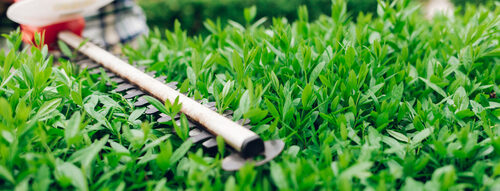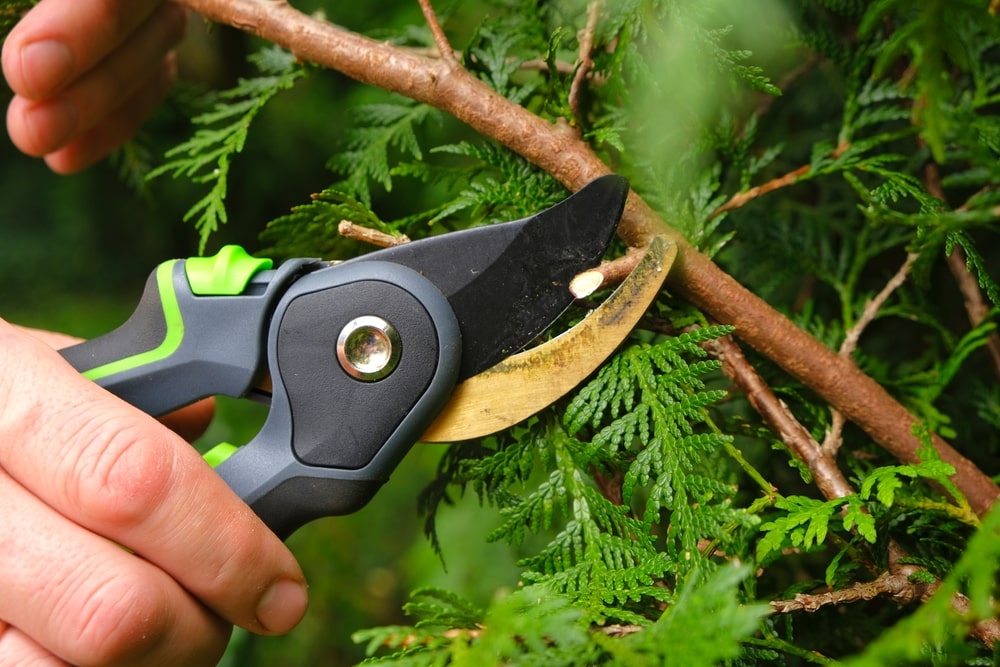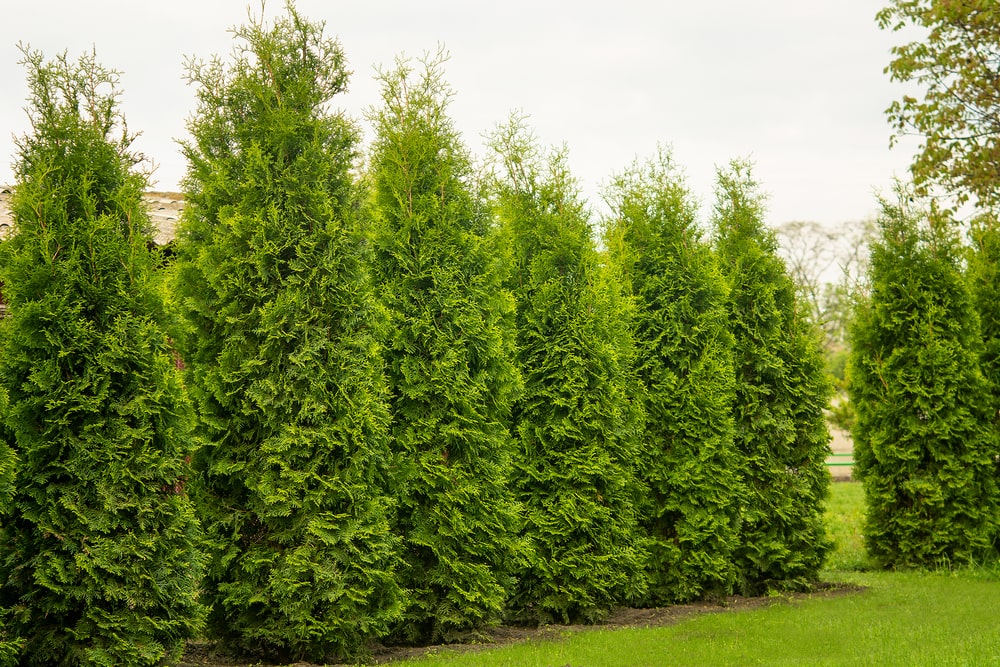Log in or create new account to save this product to your wishlist.

Hedge trimming — tips & techniques
Check out our expert tips and techniques before you tackle your hedge this year. And enjoy an easier task with excellent results every time.
🌱 All important maintenance moments for your lawn during the year. Leave your email and we will send you the lawn calendar for free.
Enter your email
Receive the lawn calendar in the mail
Enjoy a green lawn all year round!

- Order by 2PM = shipped today
- 250.000+ satisfied customers!
- 60 day satisfaction guarantee
You can shape hedges into wild figures and statues, but they also make perfect boundaries for your garden. So, understanding how to trim your hedge is an essential gardening skill, offering a neater, healthier bush that increases privacy and general garden aesthetics.
- What is your hedge variety?
- A good hedge trimming works wonders
- The classic V-cut
- The benefits of hedge trimming
- The best time to trim your hedge
- When should I avoid trimming my hedge?
- Hedge-trimming tools
- Common mistakes when cutting a hedge
- Top Tips for hedge care
- How to dispose of your hedge trimmings
- Hire a gardener to trim your hedge
- Why you should trim your hedges
- FAQs
But where do you start? Do you begin chopping at the top or the bottom? And should the sides slant like a V? Or are they best with perfect right angles?
In this article, I’ll share some expert tips and techniques for the most effective and successful hedge trimming you’re ever likely to enjoy.
What is your hedge variety?
A hedge isn’t a plant variety – a hedge is your garden’s boundary, like a fence or a wall. And there are many different plant varieties that make excellent, privacy screens for your outdoor space.
So, if you’re considering starting a hedge, you might consider the following plants:
- Privet
- Cherry laurel
- Box plant
- Cypress
- Yew
- Thuja
- Forsythia
Each plant has its own characteristics, and it’s essential to know what you’re dealing with before you pull out the hedge trimmer.
A good hedge trimming works wonders

Hedges grow tall if left untrimmed, quickly turning from eye candy to eye sore. So, trimming your hedge not only neatens your garden’s appearance but encourages healthy growth — just like mowing a lawn.
When you trim your bush, you remove dead or diseased branches, which limits potential disease and allows the plant to thrive.
The classic V-cut
Your hedge needs plenty of light to thrive, affecting how you trim the plant. If you meticulously cut the bush into a rectangle, you’ll leave a lot of the bottom of the plant in the shade.
So, a slightly trapezoidal (or V-cut) shape offers the plant a sunlight advantage. This means trimming narrower at the top and broader at the bottom.
However, some plants are fine with a rectangular cut, including privet, beech, yew, and holly.
The benefits of hedge trimming
A well-trimmed hedge helps:
- Maintain good shape and appearance
- Remove dead or diseased branches
- Minimise the spread of disease
- Give a growth spurt
- Create privacy in your garden
The best time to trim your hedge
It’s best to trim your hedge once or twice a year, depending on the appearance and the speed with which your bush grows.,
Here’s some guidance regarding when to trim your bush:
| Plant | When to trim |
|---|---|
| Box plant | Late spring/early summer |
| Privet | Late spring/early summer |
| Yew | Early- to mid-summer |
| Laurel | Late spring/early summer |
| Beech | Late summer/early autumn |
| Cypress | Late summer/early autumn |
Remember, never trim your hedge during the nesting season — between March and August. This could disturb wildlife and even kill families of birds or other creatures that live within the bush.
If you have to trim between March and August, make it a light trim with manual cutters rather than an electric hedge trimmer. Save heavy trimming between October and February.
When should I avoid trimming my hedge?
As well as nesting season, there are other occasions where it’s inadvisable to trim your hedge.
Avoid trimming during a drought or heatwave. Wait until the weather has cooled before cutting, even if the plant shows signs of illness or pest infestation. It won’t survive the assault.
Hedge-trimming tools
Having the correct trimming tools is essential for successful shearing.
Here’s a list of tools you might need:
- Hedge trimmers — the essential tool. Choose between manual or electric trimmers. Electric is more efficient but can be more expensive.
- Hand-held trimmer: while an electric trimmer is suitable for general shearing, a hand-held trimmer is better for the finer detail — pruning small branches and twigs.
- Ladder: Most hedges are taller than the average person — that way, they offer privacy. But that means you’ll need a ladder to trim the upper branches.
- Loppers: for pruning thicker branches
- Gloves: never trim without gloves, or you’ll end up with multiple cuts and grazes from thorns and spikes
- Eye protection: protecting your eyes from branches and shredding.
Always make sure your tools are clean and sharp to ensure a good cut. Cutting with blunt blades makes the job more difficult, but it could also bruise the plant where it’s exposed to the air, making it more susceptible to disease or infection.
Common mistakes when cutting a hedge
There are some common rooky mistakes people make when trimming their hedge, including:
- Over-trimming: this will leave the hedge looking bare and could affect the plant’s recovery.
- Pruning at the wrong time: avoid extreme heat and the nesting season
- Using the wrong tools: the wrong tools result in a poor trim and could affect the plant’s health
- Not wearing protective gear: hedge trimming is potentially hazardous, so always protect your hands and eyes.
Top Tips for hedge care

Hedge trimming is just one of the tasks associated with caring for your hedging plants.
Here are some additional tips to ensure your hedges thrive in your garden:
- Water your hedges regularly, especially during dry periods
- Fertilise your hedges in spring and autumn
- Spread a thick layer of mulch around the trunk to retain moisture and deter weeds
- Check your bushes regularly for signs of disease or pest infestation
- Remove dead or diseased branches as soon as possible
How to dispose of your hedge trimmings
Use your green waste bin to dispose of your hedge trimmings. It can be tempting to throw them in the corner of your garden (or even over the fence!), but dried-out hedge trimmings are remarkably flammable and could cause a fire hazard.
Remember, plant debris is a nutritional garden resource, but it will take too long for the trimmings to break down in your home composter. So, add it to your green bin/garden waste bin, and it will be composted at your local refuse centre.
Additionally, hedge trimming is messy work. Keep things tidy as you go with a garden waste bag, filling it while you trim each section.
Hire a gardener to trim your hedge

Not everyone feels confident with a power tool or manual hedge trimmer. Or perhaps you just don’t have the time or the right tools.
In this case, hire a professional gardener to make light work out of this potentially enormous garden task.
Prices for professional gardening services vary wildly across the UK. Also, the size of the hedge will affect the final cost of the job.
Professional hedge trimmers typically charge by the hour in the UK. Expect to pay between £20 and £40 per hour. As a rough guide, a regular hedge will cost around £2.50-£5 per metre, although it could be as much as £20 per metre if you’re looking for a hard trim.
Remember, go slow and make sure you have the right tools for the job. If you don’t have the tools, you could hire them or go to your local Library of Things. If that sounds too pricey, you could tackle the job yourself.
Why you should trim your hedges
Regular hedge trimming is an essential part of your gardening calendar. Not only does it keep your hedges in shape, but it also promotes healthy growth while increasing the privacy of your outdoor space.
By following the tips and techniques in this article, you’ll ensure your hedges are neat, tidy, and healthy for years to come.
FAQs
It’s best to avoid hedge trimming during the summer because this is a principal growing period for your hedging plants. Also, the summer is nesting season for birds and wildlife, so you should avoid disturbing them while they’re caring for their young. Avoid cutting your hedge in hot weather.
According to The Wildlife and Countryside Act 1981, you should avoid cutting your hedge between March and July, which is the breeding season for birds. Unless there’s an unavoidable health and safety concern, you shouldn’t trim your hedge during this period.
It’s best to start cutting from the top with tall hedges to get an even cut down the length of the hedge. However, it’s better to cut the sides first with shorter hedges, allowing you to get a neater edge along the top.
Ready to get trimming?
I hope you’ve got all the information you need to start trimming your hedges, but if you have any questions, don’t hesitate to get in touch.
Alternatively, check out our website’s extensive Help & Advice section — you’ll find a plethora of lawn care and gardening tips that should help you transform your outdoor space!
Thanks for reading, and happy gardening.
-
Orchids: A Complete Guide on How to Care for ThemWant to give your orchid the best possible care? Discover essential tips from placement to watering and pruning. Learn everything you need to know!Read more
-
Growing Wisteria Made Simple: From Planting to Perfect BloomsWith blossoms like a purple waterfall, Wisteria sets an almost magical and colourful mood. If you want to grow this beauty in your garden, you’ll need a bit of patience. Don’t worry, it will most definitely pay off.Read more
-
How to Build a DIY Greenhouse: A Practical Guide for Smart SpendersImagine extending your growing season throughout the year, nurturing tender plants regardless of the weather, and creating a personal garden sanctuary. This is precisely what a DIY greenhouse offers you. Let’s learn how to build one.Read more
-
How to Grow Eucalyptus in British GardensWith a little love and care, eucalyptus trees can thrive in English gardens. Since they don’t germinate well without proper help, there are not considered invasive. So, there is no reason not to plant them if you enjoy their looks.Read more
-
Transform Your Garden with All-Year-Round Flowering PlantsDid you know you can enjoy blooming flowers even in January? With the right selection of all year round plants, there’s no need to wait until spring to add some colour to your garden.Read more
-
How to Create a Butterfly Garden: A Simple Guide for British GardensThe UK's butterfly population includes 59 different species. These beautiful winged creatures face a steady decline because of habitat loss, pollution and changing weather patterns. Your garden can become a vital link between nature reserves and natural habitats. Let’s explore how.Read more
-
Volcanic Rock Dust for Your Garden—Application and TipsDid you know that volcanic rock dust is a brilliant organic soil improver? This article explains exactly what it's good for and how to use it properly.Read more
-
How to Use Landscape Fabric ProperlyIf weeds or erosion in your garden are troubling you, landscape fabric might be the solution. We’ll explain how and when to use it properly, just keep on reading.Read more
Leave a comment
Your answer will be displayed on the site and the interested party will be notified by email.
Leave a comment
Have a question or want to share your experience? Leave us a comment.

- Order by 2PM = shipped today
- 250.000+ satisfied customers!
- 60 day satisfaction guarantee

- Order by 2PM = shipped today
- 250.000+ satisfied customers!
- 60 day satisfaction guarantee

🌱 All important maintenance moments for your lawn during the year. Leave your email and we will send you the lawn calendar for free.
Enter your email
Receive the lawn calendar in the mail
Enjoy a green lawn all year round!






















Comments (0)
There are no comments yet. Well then, what are you waiting for to
Be the first to write your comment!inaugurate this pretty page?
Do you have some comments?